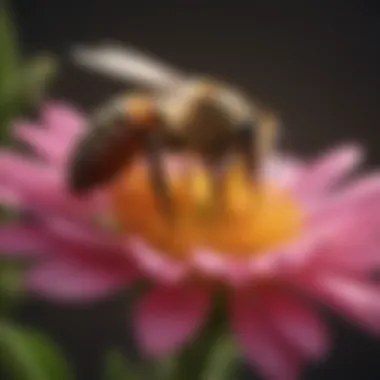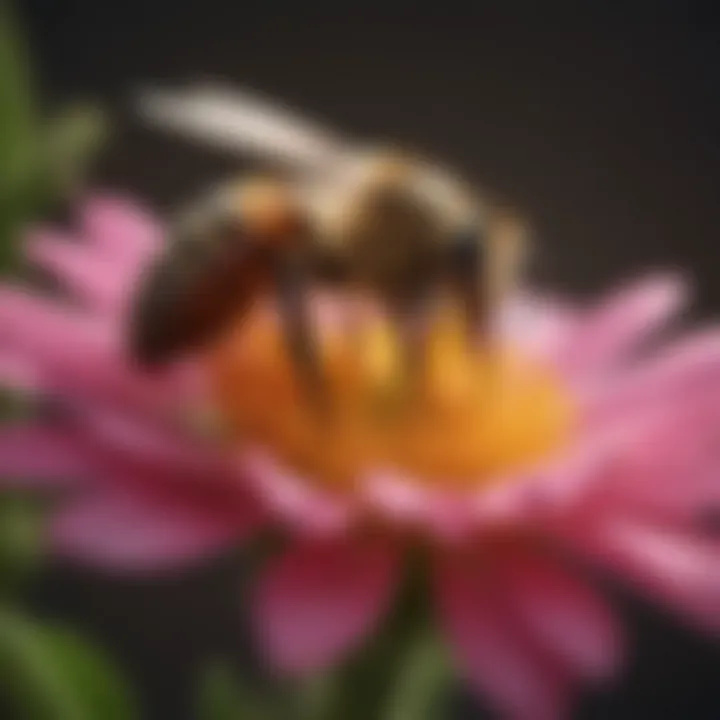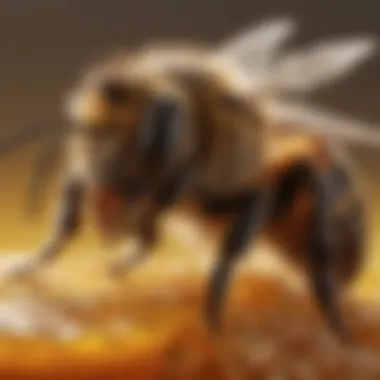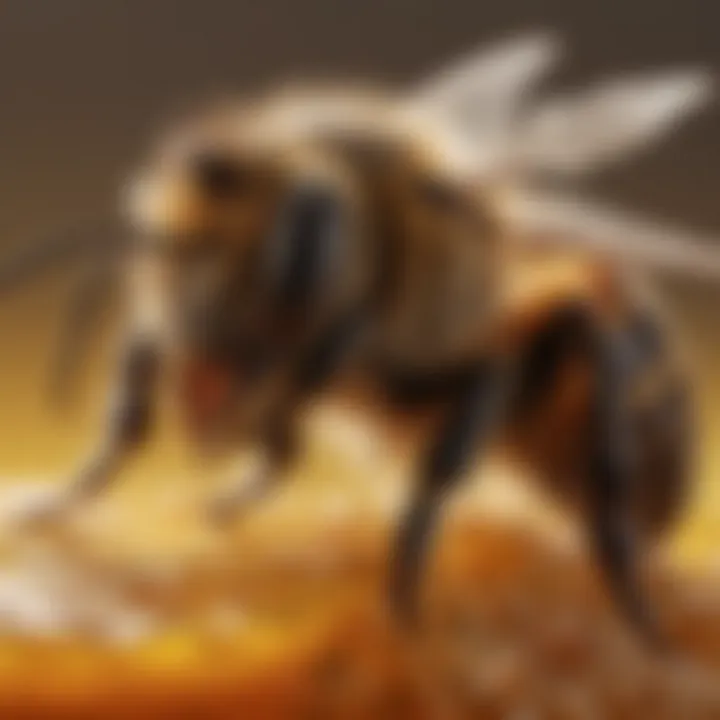Comprehensive Insights into Honey Bees for Agricultural Innovation


Intro
Honey bees play a vital role in agriculture, serving as key pollinators for many crops. Their contributions extend beyond mere pollination; honey bees profoundly influence ecological balance and agricultural productivity. Understanding their biology and social structure can lead to innovative practices in sustainable farming, thus enabling farmers and agronomists to improve crop yields and quality. This article aims to provide comprehensive insights into their significance, challenges, and conservation efforts, crucial for modern agriculture.
Topic Overview
Definition and Importance
Honey bees belong to the genus Apis and are recognized for their complex social systems. They are essential for the pollination of numerous crops such as almonds, apples, and blueberries. This service is critical, affecting food supplies and agricultural economies worldwide. Pollination by honey bees directly contributes to the growth of more than one-third of the food we consume.
Brief History and Evolution
The domestication of honey bees dates back to ancient civilizations. Evidence suggests that humans have utilized honey bees for their honey and wax for over 4,500 years. Over time, the evolution of beekeeping has aligned closely with agricultural advancements. The introduction of species such as the European honey bee has expanded their utility in various agricultural contexts.
Key Techniques and Innovations
Sustainable Farming Practices
To enhance the synergy between honey bees and farming, adopting sustainable practices is essential. These practices include:
- Crop rotation to diversify plant species during blooming periods.
- Reducing pesticide usage to minimize harm to bee populations.
- Creating pollinator habitats adjacent to farms can provide shelters and food sources.
Advanced Agronomic Technologies
Emerging technologies are shaping how farmers engage with honey bees. Innovations such as precision agriculture utilize data and analytics for optimal planting and pest management. These technologies can be aligned with the lifecycle of honey bees to ensure minimal disruption. Additionally, smart beekeeping practices allow for monitoring bee health through sensors and tracking systems.
Practical Applications
Step-by-Step Guides
Integrating honey bee management into farming can happen through straightforward strategies:
- Assess the local bee population: Evaluate if increasing colonies benefits your crops.
- Choose appropriate crops: Select plants that attract bees naturally.
- Implement regular monitoring: Check for bee activity and crop health frequently.
Case Studies or Real-World Examples
One significant example is California's almond industry, which heavily relies on honey bee pollination. Beekeepers transport hives to almond orchards annually, showcasing a successful partnership between beekeepers and farmers. This collaboration not only boosts almond yields but also enables beekeepers to sustain their operations.
"The intricate relationship between honey bees and agriculture highlights the need for their conservation and integration into modern farming strategies."
Foreword to Honey Bees and Agriculture
Honey bees play a critical role in our agricultural systems, serving as key pollinators for a vast array of crops. Their contribution is not only significant to food production but also vital for ecological balance. Understanding their function within agriculture is essential for farmers and agricultural professionals. This section outlines the intricate connections between honey bees and farming practices, emphasizing the numerous benefits they offer.
The Importance of Honey Bees in Ecosystems
Honey bees are integral to the health of ecosystems. As they forage for nectar and pollen, they facilitate the reproductive processes of flowering plants. This action supports plant diversity, leading to strong and resilient ecosystems. Several crops, including almonds, apples, and berries, depend heavily on bee pollination. The absence of these diligent insects could reduce yields and even threaten the survival of certain plant species.
Moreover, honey bees contribute to habitats that sustain a variety of wildlife. The plants they pollinate provide food and shelter for other creatures. Hence, protecting honey bee populations is not just about maximizing agricultural output; it is also about preserving the biodiversity that supports our environment.
"If honey bees were to vanish from the surface of the globe, then man would have only four years left to live." – Albert Einstein
The Symbiotic Relationship with Agriculture
The relationship between honey bees and agriculture is symbiotic. Farmers benefit from the pollination services of honey bees, which enhance crop quality and yield. In return, bees gain access to food resources. This mutually beneficial interaction is vital for sustainable farming practices.
Integrating honey bee management into agricultural systems can increase crop productivity significantly. Farmers who engage beekeepers to maintain hives on their farms report higher yields due to improved pollination. Furthermore, the presence of bees can enhance the genetic diversity of crops, leading to more robust plants.
In agricultural methodologies, it is essential to recognize the interactions between different species and the environment. Promoting a conducive environment for bees can be an effective strategy for sustaining agricultural productivity.
This overview introduces essential concepts related to the significance of honey bees in agriculture. As we delve deeper into their biology and the challenges they face, a more comprehensive understanding of their role will become evident.
Biology of Honey Bees
Understanding the biology of honey bees is vital for comprehension of their role in agriculture. Their intricate biological systems underpin their function as pollinators and their contribution to ecosystem health. Honey bees exhibit diverse anatomical structures, and comprehension of these features reveals insights into their efficiency in pollination and honey production. Moreover, knowledge about their life cycle and reproduction is essential for implementing effective management practices in agriculture. For farmers and enthusiasts, grasping these biological concepts can lead to better strategies for supporting healthy bee populations and maximizing agricultural output.
Anatomical Structure


The anatomical structure of honey bees is uniquely adapted for their roles in the ecosystem. These bees have three main body segments: the head, thorax, and abdomen. Each segment houses critical systems for their survival and efficiency in pollination.
- Head: Contains compound eyes for excellent vision, antennae for sensing pheromones and environmental cues, and mouthparts adapted for collecting nectar.
- Thorax: Fitted with three pairs of legs and two pairs of wings, the thorax is central for mobility. The legs are equipped with hairs to collect pollen, while wings enable flight.
- Abdomen: Houses the digestive and reproductive organs. The stinger, an important defense feature, is also located here.
This specialized anatomy allows honey bees to forage for food, defend their colonies, and reproduce effectively, ensuring the stability of their populations and supporting agricultural systems worldwide.
Life Cycle and Reproduction
The life cycle of a honey bee consists of four distinct stages: egg, larva, pupa, and adult. This cycle reveals how these insects develop from simple beginnings to complex organisms capable of intricate social behaviors.
- Egg Stage: A queen bee lays fertilized eggs in hexagonal wax cells. Each egg develops for about three days.
- Larva Stage: After hatching, larvae are fed royal jelly initially, then a mixture of pollen and nectar. This diet dictates their future roles; those fed solely royal jelly develop into queens.
- Pupa Stage: The larval stage transitions into a pupa, resting in the cell. During this stage, significant morphological changes occur.
- Adult Stage: Emerging as adults, honey bees take on various roles in the colony based on their age and needs of the hive. Worker bees handle foraging, while drones exist solely to mate with the queen.
Understanding this life cycle is crucial for beekeepers and farmers. It allows them to manage populations efficiently and ensure reproductive success in colonies, impacting crop yields and ecosystem balance.
Social Structure of Honey Bee Colonies
The social structure of honey bee colonies is a fascinating topic. Its complexity has significant implications for agricultural practices and pollinator management. Understanding the interdependent roles of queens, workers, and drones within a colony is essential for effective beekeeping and maximizing crop pollination. Each bee plays a vital part in maintaining colony health, which directly impacts agricultural productivity. This section will explore these roles and the communication mechanisms that coordinate the hive's activities.
Roles within the Colony
In a honey bee colony, the division of labor is clearly marked among the three types of bees: the queen, workers, and drones.
- Queen Bee: The queen has the primary role of reproduction. She can lay thousands of eggs daily, ensuring the colony’s growth and survival. Her pheromones regulate the hive's activities, making her central to the colony's functioning.
- Worker Bees: Workers are non-reproductive females that take on multiple tasks throughout their lifespan. They tend to the queen, care for the brood, forage for nectar and pollen, and maintain the hive's cleanliness and temperature. This diverse set of responsibilities ensures the colony does not just survive but thrives.
- Drones: Drones are male bees whose sole purpose is to mate with a queen. They have no role in foraging or hive maintenance, and they are expelled from the hive as winter approaches. Their existence is crucial for genetic diversity, fundamental for the colony's health.
Each of these roles emphasizes specialization. This specialization is critical for the efficiency and effectiveness of the hive. The cooperative behavior among these roles contributes substantially to successful pollination and, consequently, better agricultural yields.
Communication Mechanisms
Communication within a honey bee colony is intricate and vital. It helps coordinate activities, promote foraging, and maintain the health of the colony. Honey bees utilize several mechanisms for effective communication:
- Pheromones: Queen bees release pheromones that inform workers about her health and fertility. Worker bees produce pheromones when they find a rich food source, which helps recruit others to the location. This chemical communication is vital for hive activities.
- Dance Language: Honey bees perform a 'waggle dance' to convey directions to food sources. This dance provides information on distance and location relative to the sun. The dance helps direct other foragers efficiently, optimizing their foraging efforts.
- Vibrational Signals: Bees also communicate through vibrations. These can indicate alarm, allow the colony to focus on specific tasks, or coordinate the swarm when establishing a new colony.
Understanding these communication processes can significantly impact beekeeping practices. By recognizing how bees share information, beekeepers can manage their hives more effectively and enhance overall productivity.
Effective communication supports not only individual colony well-being but also broader ecosystem health, making this topic integral to sustainable agricultural practices.
In summary, the social structure of honey bee colonies reveals the importance of roles and communication in maintaining hive productivity. This understanding aids in managing colonies effectively, promoting agricultural innovation and enhancing crop yields.
Pollination: A Fundamental Function
Pollination serves as a vital ecological process in agriculture, directly affecting crop productivity and, consequently, food security. Honey bees, as key pollinators, engage in this process by transferring pollen from the male anthers of plants to the female stigma. This simple yet crucial act not only facilitates the reproduction of flowering plants but also enhances genetic diversity. Honey bees are particularly efficient in pollination due to their foraging behavior and social structure. The presence of honey bees can amplify yields, directly tying their health and population stability to agricultural success. Without effective pollination, many crops would yield significantly less, impacting economies and food supply worldwide.
The Pollination Process
The pollination process begins with honey bees locating flowers rich in nectar and pollen. Once a honey bee lands on a flower, it collects pollen using its hairy body, which effectively traps the pollen grains. The bee consumes some nectar for energy and gathers pollen for protein. As it visits multiple flowers, the pollen grains are transferred to new stigmas, leading to fertilization and seed production.
During this process, several factors influence its efficiency:
- Flower Variety: Certain plants attract honey bees more effectively. Varieties like sunflowers, blueberries, and apples benefit significantly from their presence.
- Timing: Honey bees are active primarily during daylight hours in warm weather. This affects when crops bloom and how bees engage with flowers.
- Diversity of Plants: A diverse range of flowers provides bees with continuous food sources, supporting their health and enhancing pollination prospects.
A well-managed flower diversity in agricultural systems optimizes pollination, thus improving overall crop yield. Studies show that crops such as almonds and cherries greatly depend on honey bees for effective pollination.
Effects on Crop Yields
The direct effect of honey bee pollination on crop yields cannot be overstated. Numerous studies indicate that honey bee activity can increase yields by as much as 30 to 100 percent for certain crops. This significant increase is attributed to:
- Enhanced Fruit Set: Pollination increases the number of fruits produced, directly impacting yield.
- Improved Seed Quality: Pollen transfer can result in better seed development, affecting future crops and overall plant health.
- Market Value: Higher yields contribute to greater market availability, maintaining the balance of supply and demand.
Furthermore, honey bees facilitate the production of many agricultural products beyond traditional fruits and vegetables. They are crucial for oilseed crops like canola, and nuts, impacting the economy on a larger scale.
Monitoring honey bee populations and implementing measures to protect their habitats are essential steps towards maintaining agricultural productivity and sustainability. Without honey bees, the agricultural landscape would face dire challenges, highlighting the urgent need for management and innovation in beekeeping practices.
Threats to Honey Bee Populations
Understanding the threats to honey bee populations is crucial for sustaining agricultural practices and securing food systems. Honey bees, being vital pollinators, face numerous challenges that hinder their survival. The decline in bee populations directly impacts agricultural productivity and biodiversity. Therefore, identifying and mitigating these threats is essential for both the environment and human food supply.
Habitat Loss


Habitat loss stands as one of the most significant threats to honey bees. With urbanization and intensive agricultural practices on the rise, natural habitats are vanishing. Fields and forests that once provided foraging grounds for bees are being replaced with concrete structures or monoculture crops. This reduction in diverse floral resources leads to malnutrition among bees, consequently affecting their capacity to thrive and reproduce.
"The health of honey bees is intricately tied to the diversity of their foraging habitats."
Moreover, the fragmentation of habitats creates isolated bee populations that struggle to find mates. This isolation can reduce genetic diversity, leading to vulnerabilities against diseases and environmental stressors. Creating patches of wildflowers and promoting biodiversity in agricultural lands can help provide the necessary support for honey bee populations during critical foraging seasons.
Pesticides and Chemical Exposure
The use of pesticides in agriculture has raised alarms among researchers and environmentalists alike. Many pesticides, particularly neonicotinoids, have been shown to be harmful to honey bees. Exposure to such chemicals can impair bees' foraging abilities, navigation skills, and overall health. High levels of chemical exposure can lead to colony collapse disorder, significantly reducing bee populations.
Farmers play a pivotal role in addressing this issue. By adopting integrated pest management practices, they can significantly minimize reliance on harmful chemicals. Alternatives such as organic farming methods, which utilize biological pest control, have shown promise in protecting bee populations while maintaining crop yield quality. Employing techniques that reduce pesticide use is a crucial step toward sustainable agriculture and healthier ecosystems.
Diseases and Pests
Diseases and pests present another set of challenges for honey bee populations. Pathogens such as Nosema and viruses like Deformed Wing Virus can devastate colonies. Additionally, the Varroa mite acts as a significant parasite that weakens bees by feeding on their bodily fluids. These threats, often exacerbated by environmental stressors, can lead to colony losses unless managed properly.
Regular monitoring and veterinary care are essential for beekeepers who wish to maintain healthy colonies. Implementing biosecurity measures, such as quarantining new bees or equipment, can reduce the risk of spreading diseases and pests. Furthermore, enhancing the overall resilience of bee colonies through practices like genetic selection can improve their survival rates against these adversities.
In summary, honey bees face multiple threats that endanger their populations and, by extension, the agricultural systems that depend on their pollination services. Habitat loss, pesticide exposure, and the presence of diseases and pests are critical factors that require attention and action. By fostering awareness and implementing better management practices, we can work toward a healthier environment for honey bees and a sustainable future for agriculture.
Conservation Efforts for Honey Bees
The significance of conservation efforts for honey bees cannot be overstated. Honey bees play a critical role in pollination, which is essential for the growth of many crops. By safeguarding their populations, we help sustain food production and protect biodiversity. Many organizations and communities are recognizing this need. As a result, collective actions are emerging aimed at addressing the various challenges that honey bees face.
Community Initiatives
Community initiatives are vital in the effort to conserve honey bees. Local organizations often come together to promote awareness about the importance of bees and their habitat. Such initiatives include educational workshops, public awareness campaigns, and community gardens designed to support bee populations. Gardening programs can encourage the planting of bee-friendly flowers and plants. These activities not only educate individuals but also contribute to an increase in local biodiversity.
In addition, community apiaries allow residents to engage directly with beekeeping. Participants learn management practices and observe the contributions of bees to the ecosystem. Success in these community-based approaches often depends on collaboration between locals, schools, and gardening clubs. Educating the public about the critical role of honey bees fosters a culture of conservation, which can have long-lasting impacts.
"Community-driven conservation can effectively raise awareness and promote sustainable practices to protect honey bee populations."
Sustainable Agricultural Practices
Adopting sustainable agricultural practices is another essential aspect of conservation efforts for honey bees. Farmers play an important role in creating an environment conducive to bee health. This includes minimizing pesticide use, which has been a significant factor in the decline of bee populations. Instead, integrated pest management strategies can help control pests while reducing the negative impact on bees. Utilizing organic farming techniques is another way to enhance the safety of the environment.
Incorporating cover crops can also improve soil health while providing food sources for honey bees. Diverse planting strategies promote better biodiversity in agricultural landscapes. Providing habitat through wildflower strips can further encourage honey bee visitation. These practices not only support the health of bees but can also increase the resilience of agricultural systems.
Integrating Honey Bee Management in Farming
Integrating honey bee management into farming is not just beneficial; it is crucial for enhancing agricultural productivity. Honey bees offer extensive pollination services that are essential for a variety of crops. When farmers collaborate with beekeepers, they can create an environment that maximizes the effectiveness of pollination while ensuring the health of bee populations. This section will highlight specific elements, benefits, and important considerations related to this integration.
Best Practices for Beekeepers
Beekeepers play a pivotal role in maintaining healthy honey bee populations that can significantly benefit agricultural yields. Implementing best practices is essential for both the sustainability of beekeeping operations and the effectiveness of pollination in agriculture. Some core practices include:
- Regular hive inspections: Checking the health of the colonies helps identify diseases, pests, and general hive conditions early on.
- Providing diverse forage: Planting a variety of flowering plants around farmland ensures that bees have access to ample nutrition, boosting their health and productivity.
- Utilizing appropriate hive management techniques: This includes methods for swarm prevention, disease management, and optimal hive placement within fields to maximize pollination efforts.
- Educating farmers: Beekeepers should share knowledge with farmers about the importance of bees and how their management choices can impact bee health.
- Adhering to organic practices: Minimizing chemical use can protect the bees and improve the quality of the crops being pollinated.
Incorporating these practices helps foster a cooperative relationship between farmers and beekeepers, ultimately leading to better agricultural outcomes.
Collaborating with Beekeepers
Collaboration between farmers and beekeepers can yield significant advantages. This partnership can enhance productivity in the field and promote healthy bee populations. Here are some ways to facilitate collaboration:
- Communication is key: Regular discussions between beekeepers and farmers can align their goals. Farmers can inform beekeepers about their crop cycles and flower availability, while beekeepers can share insights on bee behavior.
- Shared resources: Together, beekeepers and farmers can work on creating pollinator-friendly habitats that benefit both parties. This may involve planting wildflower strips or preserving hedgerows that provide foraging opportunities.
- Mutual education: Workshops and joint training efforts can equip both groups with knowledge about bee health and sustainable practices.
- Adapting practices: Beekeepers should adjust hive placements according to farmers’ needs. For instance, moving hives closer to fields during peak blooming periods can significantly enhance pollination services.
Collaborating with beekeepers not only amplifies crop yields but also fosters an ecosystem in which both agriculture and pollinators can thrive.
The Role of Honey in Agriculture
Honey is not just a sweet treat; it serves several viable purposes in agriculture. Emphasizing its roles can lead to increased awareness about the significance of this product. Firstly, honey has notable nutritional benefits which contribute to dietary diversity. Secondly, the economic value of honey production cannot be underestimated. These aspects make honey an essential component in discussions about agricultural practices and sustainability.
Nutritional Benefits
Honey provides several nutritional advantages, making it an attractive ingredient in many diets. It contains various vitamins, minerals, and antioxidants. Some crucial components include vitamin C, calcium, and iron. Moreover, honey is a natural energy source. Due to its high carbohydrate content, it serves as a quick fuel for the body. Consuming honey may also have benefits for digestion and immunity. It is often used in natural remedies due to its antimicrobial properties.
In agricultural production, promoting honey as a nutritional supplement can enhance the overall public perception of farming. Encouraging farmers to diversify into honey production can not only improve community health standards but also generate awareness about the benefits of beekeeping.


Economic Value of Honey Production
The economic impact of honey production on agriculture is significant. Honey production can be a lucrative venture for farmers. The growing demand for organic and natural products means that honey is increasingly sought after. Many consumers are willing to pay premium prices for high-quality honey. This willingness translates into profitable opportunities for beekeepers.
Additionally, honey production can contribute to local economies. It fosters job creation in farming, packaging, and distribution sectors. Beekeeping also supports the local blossoms and crops, which positively affects broader agricultural yield.
"Investing in honey production not only supports farmers financially but also sustains local ecosystems."
In consideration, it is worth noting the necessary investments in training and resources for prospective bee farmers. While starting a honey production business may require upfront costs, the long-term benefits can outweigh these expenses. In essence, honey plays a vital role in viable agricultural practices, boosting both health and the economy.
Honey Bees and Biodiversity
Honey bees play a vital role in maintaining biodiversity within ecosystems. Their activities as pollinators not only support the growth of various plants but also contribute to the overall health of the environment. A decline in honey bee populations could lead to significant disruptions in food chains, impacting both agriculture and natural habitats.
Supporting Ecosystem Diversity
The relationship between honey bees and ecosystem diversity is complex. By pollinating a wide range of flowering plants, honey bees enable the reproduction of many species. This in turn supports a variety of other organisms that rely on these plants for food and habitat. Diverse ecosystems tend to be more resilient and can better withstand environmental changes.
- Pollination promotes genetic diversity in plants, leading to healthier ecosystems.
- A higher variety of flowering plants leads to increased food sources for other wildlife.
- Healthy ecosystems support services like clean water and soil fertility, crucial for agricultural success.
Involved researchers must focus efforts on preserving these key pollinators. This might include creating suitable habitats and reducing environmental stressors.
Honey Bees as Indicator Species
Honey bees can also serve as indicator species for ecological health. Their sensitivity to environmental changes makes them perfect for monitoring ecosystem stability. When honey bee populations decline or show stress, it can be a sign that the ecosystem is facing larger issues.
"The health of bee populations reflects the health of the environment, reminding us of our interconnectedness."
Factors including pesticide exposure, habitat loss, and climate change can affect honey bee populations, and studying these effects can reveal important information about the underlying conditions of the ecosystem.
- Monitoring honey bee behavior lets scientists track environmental changes.
- Population health can indicate the effectiveness of conservation efforts.
- A stable honey bee population often correlates with a broader healthy ecosystem.
In summary, honey bees do not only contribute to agriculture and food production; they are integral to maintaining biodiversity and serving as crucial indicators of environmental health.
Future of Honey Bees and Agriculture
The future of honey bees and their integration in agriculture carries immense significance for numerous stakeholders. As agriculture continues to evolve due to climate change, technological advancements, and changing consumer demands, the role of honey bees demands careful consideration. The health of honey bee populations correlates directly with agricultural productivity, given their essential role in pollination. Any decline in bee health inevitably affects crop yields and biodiversity. Thus, securing the future of honey bees is not just about protecting a species; it is paramount for sustaining food security and agricultural stability.
Innovations in Beekeeping Technology
Technological strides have dramatically changed beekeeping practices. Innovations such as smart hives equipped with sensors collect real-time data on hive health and activities. This information helps beekeepers make informed decisions quickly. Another key advancement is the use of artificial intelligence for monitoring bee behavior and identifying potential issues before they escalate.
Furthermore, the development of more resilient bee strains through selective breeding shows promise in counteracting some environmental stresses, making bee colonies stronger. Drones are also utilized in pollination and hive inspections, enhancing efficiency. These technologies not only improve the productivity of beekeepers but can also contribute to more sustainable practices in farming overall.
Policy Implications and Support
The future of honey bees in agriculture heavily relies on supportive policies. Governments and organizations must recognize the critical role of bees in ecosystems and economy. Creating policies to promote habitat restoration and the reduction of pesticide usage is crucial. Such measures can safeguard honey bee populations while ensuring farmer interests align with ecological sustainability.
Moreover, funding for research into bee health and development of best practices in beekeeping should be prioritized. All these policies work towards a holistic support system for honey bees, empowering community and educational initiatives aimed at raising awareness about their plight.
"Protecting honey bees is not merely an agricultural concern; it is an essential aspect of maintaining ecological balance and ensuring our global food supply."
Supporting bee populations through informed policy can also stimulate community-driven conservation initiatives. Farmers, educators, and community groups can collaborate under supportive frameworks, creating resilient ecosystems that benefit both bees and agriculture.
The End and Call to Action
The conclusion of this article aims to synthesize the vast knowledge shared about honey bees and their pivotal role in agriculture. It emphasizes the pressing need for collaboration among farmers, beekeepers, and stakeholders in agricultural innovation. The interdependence of honey bees and farming practices cannot be overstated. By recognizing their contributions to pollination and the overall ecosystem, individuals can take steps to support these essential creatures.
Importance of Individual Efforts
Every individual plays a crucial role when it comes to the conservation of honey bees. Small actions can collectively lead to significant impacts. Here are some important points to consider:
- Creating Pollinator-Friendly Habitats: Individuals can plant native flowers and avoid pesticides in their gardens. This not only supports honey bees but also enhances local biodiversity.
- Supporting Local Beekeepers: Purchasing honey and bee products from local producers fosters sustainable practices within the community.
- Advocacy: Individuals can advocate for policies protecting honey bee habitats and support initiatives promoting organic farming and reduced pesticide usage.
Taking such steps not only aids in the effort to conserve honey bee populations but also contributes to healthier ecosystems.
Encouragement for Ongoing Education
Ongoing education is vital for understanding the complexities surrounding honey bees and their relationship with agriculture. Committing to continuous learning can empower individuals and communities. Here are key aspects of this educational journey:
- Workshops and Seminars: Participating in local workshops can provide insights into beekeeping and the challenges faced by honey bees. Knowledge from experts can be invaluable.
- Online Resources: Websites such as wikipedia.com and britannica.com offer extensive information about honey bee biology, ecology, and conservation efforts.
- Community Engagement: Joining local beekeeping clubs or agricultural organizations can foster collaboration and shared learning experiences.
Education empowers action. As people become more informed, they can engage in more thoughtful practices that ultimately benefit honey bees and, in turn, agriculture.
"The health of the planet, agriculture, and honey bees is intertwined. Individual actions contribute to a collective future."



